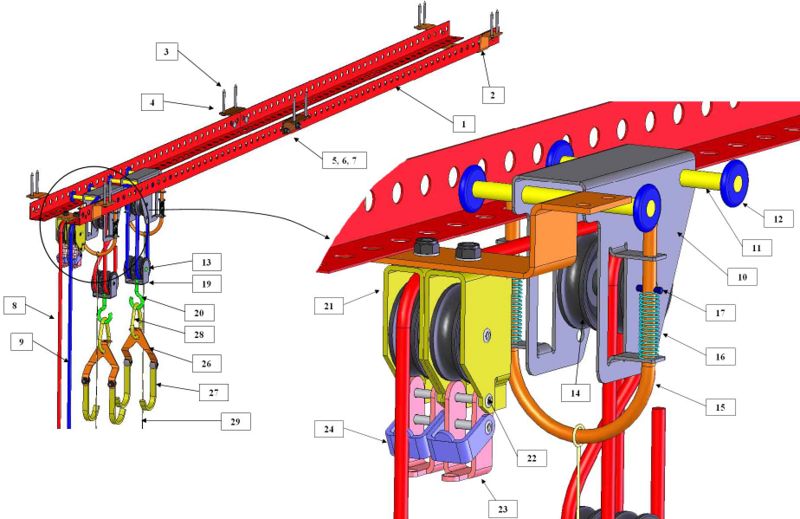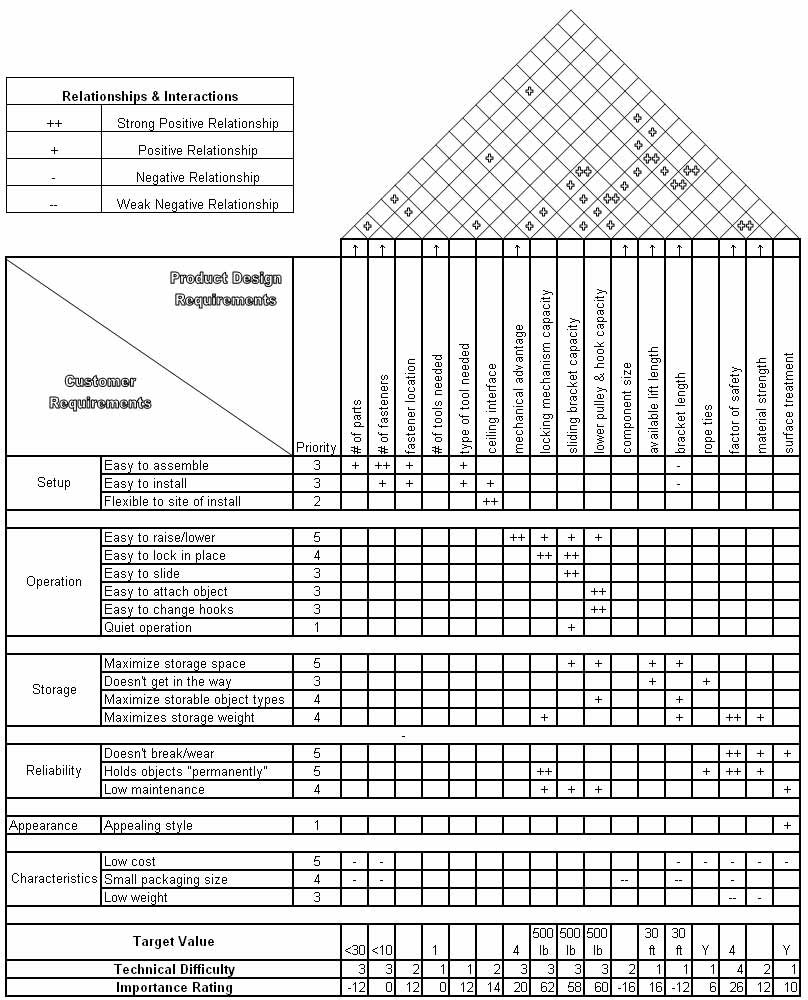Ceiling-mounted storage lift
From DDL Wiki
m (→Consumer Assembly) |
|||
| Line 40: | Line 40: | ||
==Engineering Analysis== | ==Engineering Analysis== | ||
===Design for Manufacture and Assembly (DFMA)=== | ===Design for Manufacture and Assembly (DFMA)=== | ||
| + | In designing the ceiling-mounted storage lift, we employed many of the same DFM techniques that were used to design the ceiling-mounted bicycle lift. Minimizing the number of unique parts lowers production costs by reducing the amount of new machines and tooling to create those parts. Minimizing the total number of parts also reduces costs for raw materials as well as reduces weight and keeps transportation costs low. The ceiling-mounted bicycle lift minimized parts well with only 19 unique parts and 66 total parts. We greatly increased the functionality and complexity in our design while only increasing the number of unique parts to 29. The total number of parts in our design is 121. When possible, we incorporated duplicate parts and subassemblies in our design. For example, the upper and lower bracket assemblies appear twice and are identical. The ceiling mounts are also identical with one mount having two identical locking mechanisms attached. The only non-duplicated part in the design is the single wall rope tie. | ||
| + | |||
| + | In addition to keeping the number of unique parts to a minimum, it is also cost effective to use parts that are already in production for other products and may be purchased. This eliminates the cost of creating new machines. Of our 29 unique parts, 18 are parts that are already in production and may be purchased. Of the 11 parts that must be custom built, there are only 4 parts that are not already custom built for the ceiling-mounted bicycle lift. Ten of the eleven custom parts are stamped and bent from steel sheet metal. The remaining custom built part is the aluminum U-rod that is manufactured using the common manufacturing process of extrusion and bent into shape. The only post machining for the U-rod is to cut a taper on the ends of the rod. By using the manufacturing process of stamping for almost all of our custom parts, we eliminate the need for any post machining. We designed the stamped parts this way to make them very cost effective to be produced in high volume. Stamping will create some waste material, but this material can be gathered and recycled to create more parts. Overall, we feel that the design for the ceiling-mounted storage lift does not require any costly or complex manufacturing processes and is suited well for mass production at low cost. | ||
| + | |||
| + | |||
| + | |||
===Design for Usability (DFU)=== | ===Design for Usability (DFU)=== | ||
===Design for Safety (DFS)=== | ===Design for Safety (DFS)=== | ||
Revision as of 16:45, 6 May 2007
This article was contributed as part of a design project for the course 24-441 Engineering Design in the spring semester of 2007 at Carnegie Mellon University.
Team 1 - Report 1: Ceiling-mounted bicycle lift
Team 1 - Report 2: Ceiling-mounted bicycle lift redesign
Contents |
Executive Summary
Project Background
For our senior capstone design project, we were to work in groups to analyze a current product on the market with some engineering involved in the design. Our group of four decided to analyze a ceiling mounted bike lift. For the project, we were to fully understand the functionality of the product and dissect it. Then we were to find opportunities by brainstorming where we could enhance the product or its functionality. Finally, we were to build several prototypes demonstrating our ideas and improvements to the current design.
With our selection of the ceiling mounted bike lift, we found several opportunities where we could improve and change the current design. These improvements include increasing the functionality of the lift, allowing the user more flexibility in the usage of the lift, increasing the maximum lift load and diversifying the product from its competitors on the market. This project has allowed our group to work across several business lines from engineering to marketing to production. The project concluded with our presentation of our final prototype. The details of our opportunity, findings, analysis, design and conclusions will follow.
Opportunity & Market Research
Product Description
Components
The Ceiling-mounted storage lift BOM contains the quantity of each component in this product, the weight of that component, its function, the material it's made of and its most likely manufacturing process. It also contains both a CAD image and a dimensioned drawing of each custom part and a catalog reference for each purchased part. The design is comprised of 121 total parts with 29 unique parts. The total weight is 4.1 kilograms or approximately 9 pounds. The ceiling mounted storage lift has been designed to use a minimal number of parts while still being capable of its desired functionality. The DFMA section of this report includes further detail on some of the considerations that were made in designing many of these parts.
Pre-Packaging Assembly
There are three major sub-assemblies that need to be assembled prior to packaging and then shipping the product. The remainder of the assembly process is to be completed by the consumer. These major assemblies can be seen below: the sliding bracket(1), the lower bracket(2), and the rope locking bracket(3). Please follow the link next to each image for a detailed description on how these components are to be assembled.
1: Storage Lift Sliding Bracket Assembly
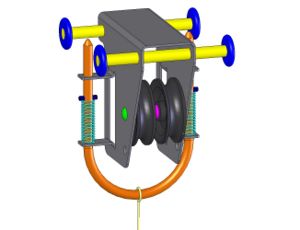
2: Storage Lift Lower Bracket Assembly
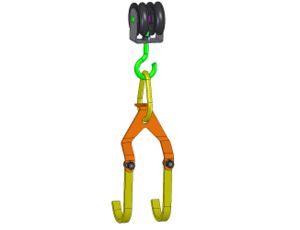
3: Storage Lift Locking Bracket Assembly
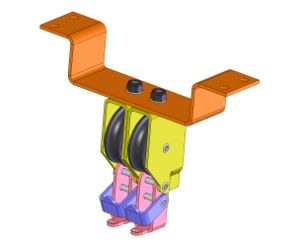
Consumer Assembly
---summary of consumer assembly--- Please refer to the Storage Lift Consumer Assembly page for a detailed description of the steps the consumer will need to follow to properly install the product.
Engineering Analysis
Design for Manufacture and Assembly (DFMA)
In designing the ceiling-mounted storage lift, we employed many of the same DFM techniques that were used to design the ceiling-mounted bicycle lift. Minimizing the number of unique parts lowers production costs by reducing the amount of new machines and tooling to create those parts. Minimizing the total number of parts also reduces costs for raw materials as well as reduces weight and keeps transportation costs low. The ceiling-mounted bicycle lift minimized parts well with only 19 unique parts and 66 total parts. We greatly increased the functionality and complexity in our design while only increasing the number of unique parts to 29. The total number of parts in our design is 121. When possible, we incorporated duplicate parts and subassemblies in our design. For example, the upper and lower bracket assemblies appear twice and are identical. The ceiling mounts are also identical with one mount having two identical locking mechanisms attached. The only non-duplicated part in the design is the single wall rope tie.
In addition to keeping the number of unique parts to a minimum, it is also cost effective to use parts that are already in production for other products and may be purchased. This eliminates the cost of creating new machines. Of our 29 unique parts, 18 are parts that are already in production and may be purchased. Of the 11 parts that must be custom built, there are only 4 parts that are not already custom built for the ceiling-mounted bicycle lift. Ten of the eleven custom parts are stamped and bent from steel sheet metal. The remaining custom built part is the aluminum U-rod that is manufactured using the common manufacturing process of extrusion and bent into shape. The only post machining for the U-rod is to cut a taper on the ends of the rod. By using the manufacturing process of stamping for almost all of our custom parts, we eliminate the need for any post machining. We designed the stamped parts this way to make them very cost effective to be produced in high volume. Stamping will create some waste material, but this material can be gathered and recycled to create more parts. Overall, we feel that the design for the ceiling-mounted storage lift does not require any costly or complex manufacturing processes and is suited well for mass production at low cost.
Design for Usability (DFU)
Design for Safety (DFS)
Safety was a primary consideration in the design of the ceiling-mounted storage lift. We took the time to analyze and verify the design of each component so that the failure mode of the product in extreme conditions is one that will not cause major damage or injury. Similar to the ceiling-mounted bicycle lift, the primary mode of failure in an overloaded condition is slippage of the rope through the locking mechanism. We performed tests on the ceiling-mounted bicycle lift to determine the maximum loading that would cause failure. We gradually increased the weight of the object hung from the lift and applied a dynamic load to see if the lift would fail. The results of our testing showed that the lift failed when a dynamic load was applied to an object with a weight of 240 pounds. A video of the testing can be seen at the following link: http://www.youtube.com/watch?v=2OQ_4o4JSPw .
Since the pulley system in the ceiling-mounted bicycle lift has a mechanical advantage of four to one, the tension in the rope is 60 pounds for a maximum load of 240 pounds. In our design, a tension of 60 pounds in each rope corresponds to a load of 480 pounds. To insure that the primary mode of failure in our design is slippage in the rope, we analyzed and verified that the structural components of concern in our design are capable of withstanding a load of 600 pounds. The components we analyzed were the wheel axles and the pulley brackets. The analyses are shown in detail on our Ceiling-mounted storage lift numerical analysis page. From our axle sizing table, we were able to select the appropriate axle diameter once we determined the separation distance between the wheel and the side of the pulley bracket. To minimize torsion on the L-channel track, we decided to place the wheels as close as possible to the vertical wall of the track. This makes the separation distance 1.25 inches. We sized our axles for steel with a yield strength of 40,000 psi and chose a diameter of 5/16 inches. We also performed a finite element analysis using ANSYS to verify the structural integrity of the pulley brackets. We performed the analysis on simplified shapes and concluded that our pulley brackets would not fail under the same load.
Failure Mode and Effects Analysis (FMEA)
The FMEA for the ceiling-mounted storage lift is effectively identical to the Ceiling-mounted bicycle lift FMEA. In our first report, we identified two distinct failure modes that we felt needed to be addressed. Both failure modes were due to one component, the locking mechanism. Since we re-use this part in our design, we still recommend making the same changes that we suggested in the first report. Our recommendations are restated below. The part numbers are in reference to the Ceiling-mounted bicycle lift parts list.
If the user is standing on the side of the locking mechanism that the bike is on (not the normal standing position) and were to let the rope go, the locking mechanism would not be able to perform it's function of catching the rope and stopping the bike from free falling. The cause of this problem comes from the range of rotational motion of the clutches(9,10) on the locking mechanism. If this range was reduced by roughly 2 to 3 degrees, this entire failure mode could be eliminated. This could be accomplished with a small change to the design of the locking pulley mount(8), in which the bottom tab was made a few millimeters wider. This would not affect the current 8 degree rope angle needed for immediate engagement of the locking mechanism under proper usage. The repeated testing of this component ultimately led us to discover the second most severe failure mode of our analysis.
The components of the locking mechanism that pinch the rope, thus holding it in place, make contact with the rope over a relatively small area. Thus, repeated latch engagement is fairly harsh on the rope and after just several weeks of normal use, obvious signs of rope deterioration become apparent. The rope supplied with this product is sufficiently robust from a tensile load capacity standpoint. Replacing it with a rope made from a less standard material that has better surface wear resistance, although would be simple, we feel as though it would not make fiscal sense. Instead we propose a design change be made to the clutches(9,10) that engage the rope, in which they are given a more blunt surface that makes contact with the rope over a larger area, away from any sharp edges. This will not necessitate any other design changes to accomodate for this modification, which is why we believe this course of action to be the most cost effective change that solves the problem at hand.
Quality Function Deployment
Conclusion
---add summary here---
Final Prototype
User-testing
Conclusion
Production Plan
Group Members: Jeff Polack, Kevin Pruzinsky, Davey Quinn, Russel Verbofsky
